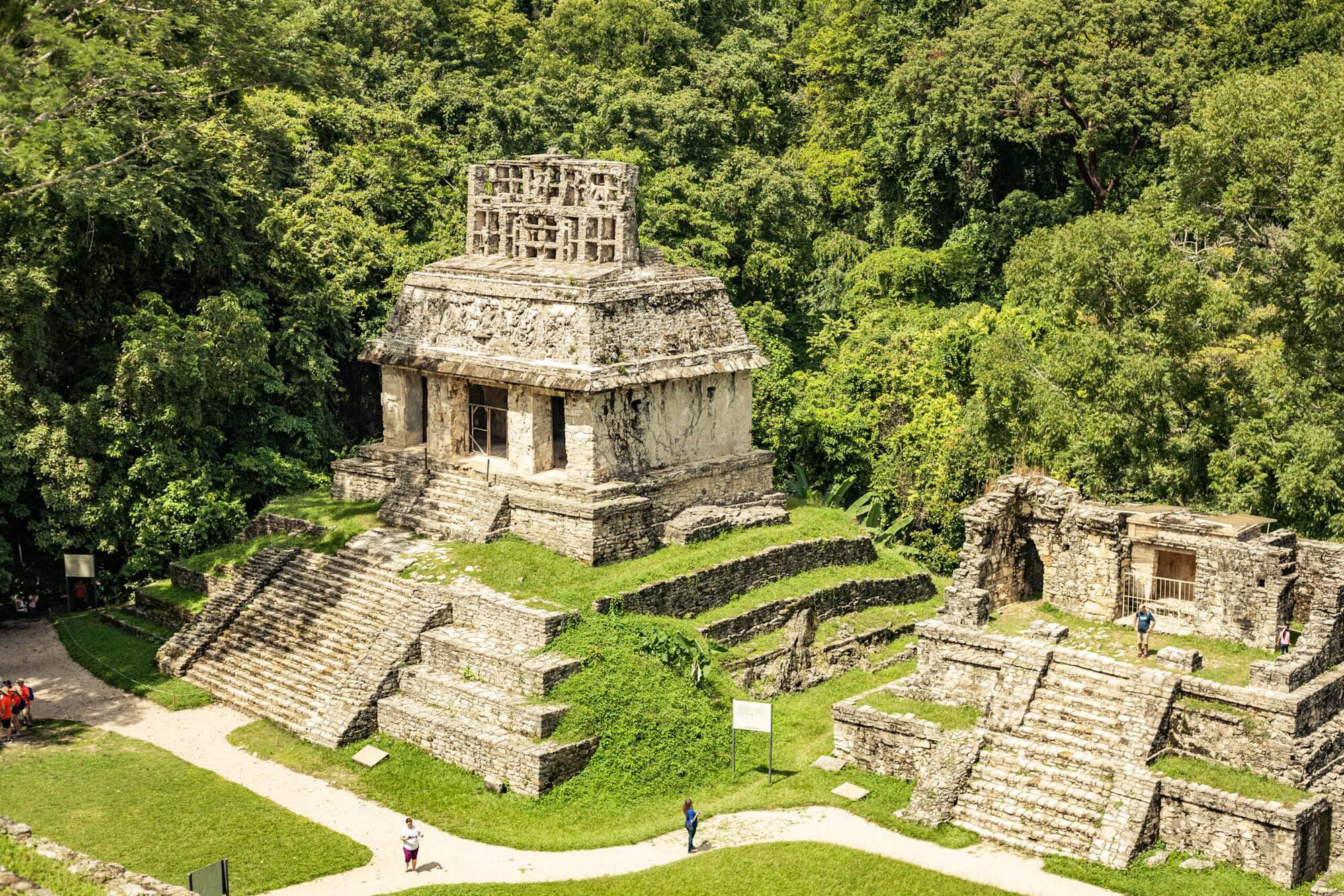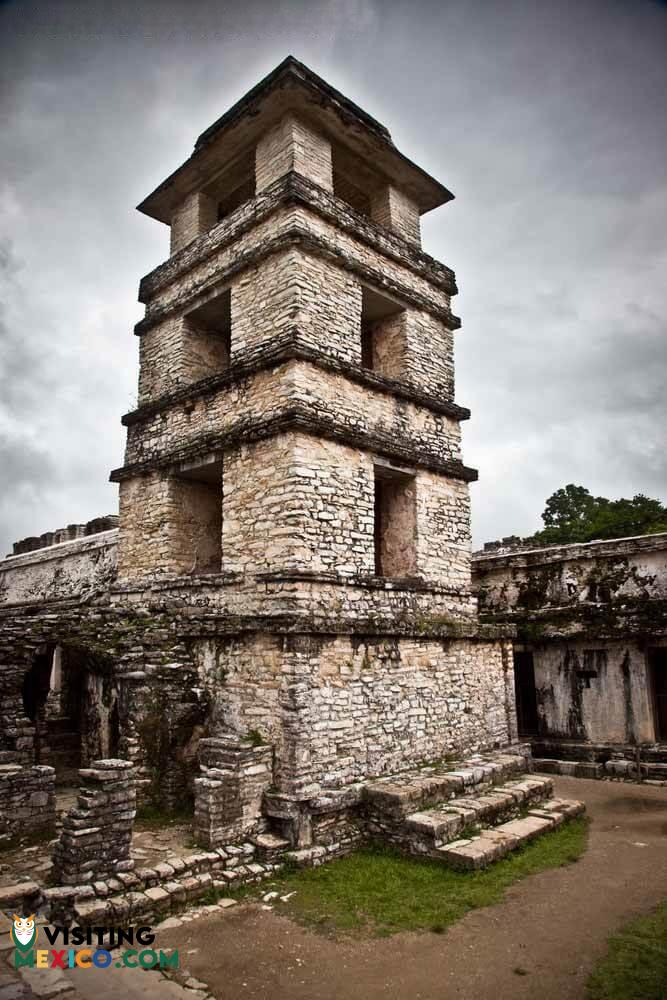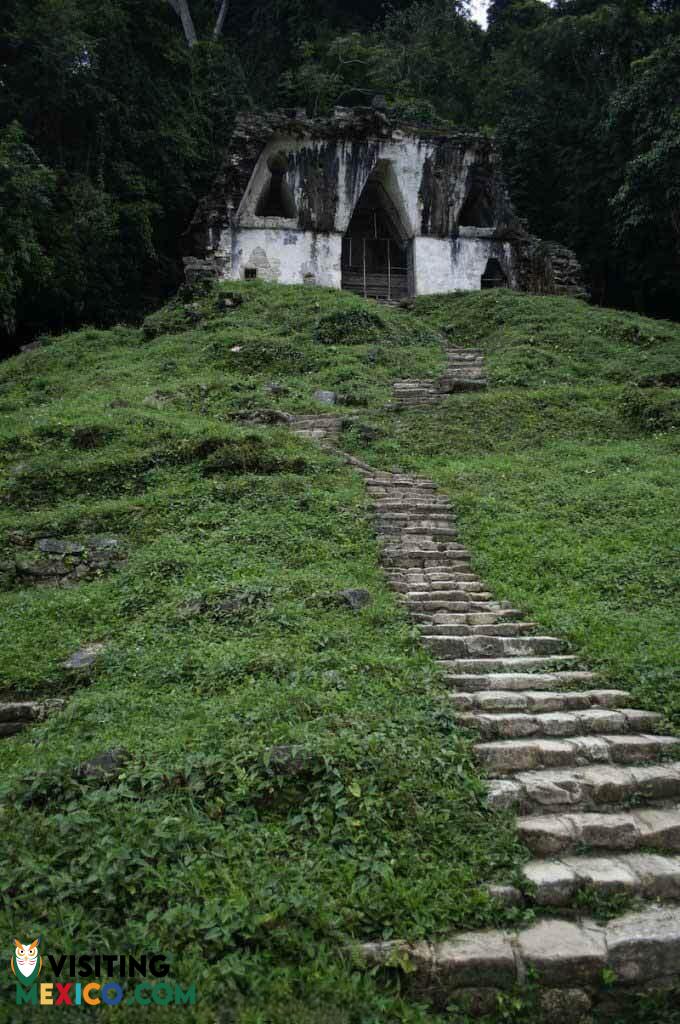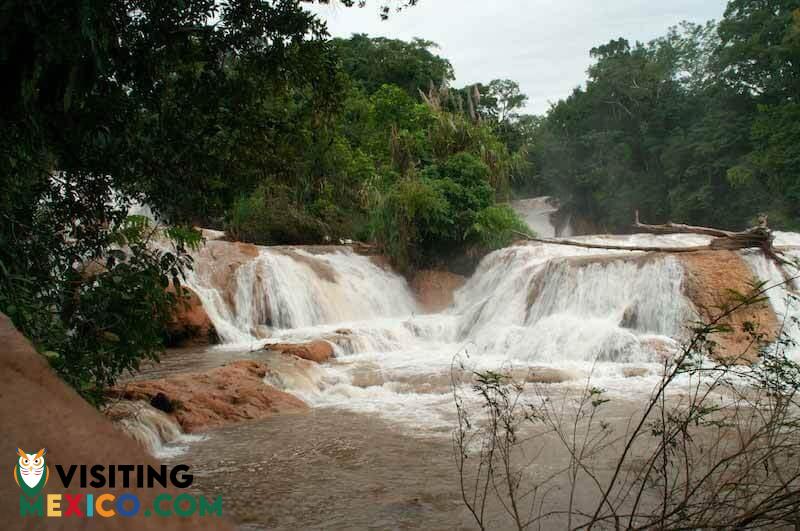
There is more to what makes Chiapas intriguing than physical and political differences. All of Chiapas is a magical mystery tour. Palenque is the epicenter of its spirituality. If you believe in magic, or are at least open to it, you will have a more exceptional experience visiting Palenque than less imaginative folks. But even they will appreciate its uniqueness.
The archeological site of Palenque is much different and for many, has more character than the more well-known and easier to get to sites in the Yucatan Peninsula. This reinforces my opinion that the truly interesting areas of Mexico are better visited by cars, motorcycles and RVs. Palenque is in the northeastern end Chiapas state, near the Gulf of Mexico. It is a natural stop if you are driving from Veracruz to the Yucatan Peninsula.
First impressions of Palenque can deter you from delving deeper. Don’t let them. There is more wildlife (monkeys, parrots, lots of birds, iguanas, butterflies, bugs and spiders) here than at many ruins. OMG, is it ever humid! And the mosquitoes!
Perhaps those are defenses left behind by the ancient Mayans to keep the throngs of tourists away. Look deeper. Better yet, feel deeper. Spend a day at the ruins. Spend dusk or dawn in a garden at your hotel listening to the birds, parrots, monkeys, insects. Realize how insignificant you are.
Even though Palenque is perhaps the most studied and written about Mayan site by archeologists, it does not get nearly as many tourists as Chichen Itza (Yucatan) and Tulum (Quintana Roo). Since it gets fewer foreign tourists, it is less crowded, less commercial and more natural. Even today the jungles around the site and the town are alive with howler monkeys. Today, they are less common than when I first came here in the 1980s, but one screaming you awake in the morning is plenty. Chichen Itza is on a flat, barren plain. Palenque is actually in a jungle. I’m amused by tourists who rave about the jungle setting of Chichen Itza. Palenque is the real deal. In summer it is really hot and really humid. In winter it is just humid and warm.
When the economy is good, many Palenque hotels raise their prices beyond reasonable. Because of the Corona pandemic, prices are quite low now and probably will be when travel resumes.
HISTORY OF PALENQUE
Palenque had been abandoned by the Mayans hundreds of years before the Spaniards arrived. Only an estimated ten percent of the ancient city has been uncovered. The most well-known temple there is the Temple of Inscriptions which was both a temple and a funerary monument housing a sarcophagus.
MYSTERY OF PALENQUE
Even if you are not into archeology, you can enjoy Palenque. To get to the temples “in the back,” you walk a path through some barely trimmed jungle. If you stop, close your eyes and still your mind, you might have an other-worldly experience. I know several people who have had visions or “vibes” of long-dead Mayans communicating with them in the area around the Palenque ruins.
If visitors from the past are not your bag, you can sit on one of the concrete benches in the first (flat) section of the site. Some are blessedly under trees. You will see wandering tribes of backpackers, mostly European, all on the Lonely Planet trail. On my last visit, I was treated to a show by a painfully single American guy clumsily trying to pick up European chicks. His shtick was that he knew all the ruins and the best hostels and cheap hotels. Of course, like all the backpackers, his knowledge was from the Lonely Planet guide, so he had nothing to offer. As soon as the Euro-birds figured that out, they flitted away. I wondered – was I ever that way? Yeah, probably. But I’m sure I was smoother.
Listening to the young tourists made me sad. It wasn’t that I am an old man and they were young. I was saddened that they were traveling in packs of other tourists. Their “Mexican experience” was limited to bus stations, finding cheap hotels and following LP slavishly. They didn’t experience Mexico – they experienced the same people, the same cultures of their tribes. Was that why they came to Mexico?
These same people (and I was a member of the tribe in the 1970’s) deride older Americans who traveled in bus tours. But what difference was there in terms of experiencing the culture of the country they were visiting?

PALENQUE RUINS
The principal attraction, on a mundane level, is the Zona Arquelógica Palenque. These ruins are impressive, not because of their size, but because of their surroundings. Those in charge wisely left the jungle to grow naturally instead of denuding it as at some other ruins. The area around the pyramids is cleared and grassy. There are benches (some shaded by trees) where you can sit, gaze at the structures and allow their magic to surround you. Trust me, it will if you are willing. The area is serene but not silent. Besides parrots and other birds, the howler monkeys add a background soundtrack. Though it may seem like there are hundreds of them, they just jump around a lot. A scientific survey in 2000 found 136 individuals (which included 3 solitary males who were just passing through and not part of the local troops). The sound of these creatures is eerie and can be heard at some hotel grounds near the head and throughout the wilder areas.
Tourists who flock to Palenque are a diverse group. They are quite different from the busloads of Bermuda shorts-wearing fly-by tourists who overwhelm Chichen Itza. To start with, most have at least a fundamental appreciation for the features that make Palenque unique. They’ve usually read something about it. Some are elder, often making a return visit to this sacred place for some peace and solace at a major transition in their lives. They’re usually the ones wearing safari gear.
Younger tourists are a mixed bag. Lots of backpackers fill the cheap hotels and hostels. They, like the howler monkeys, travel in troops, with an occasional lone male seeking admittance. Most of them are European, or Americans pretending to be. Hey, I was young once too. Their nexus is the Maybell (3 ½ MI (5 ½ KM) from the Mayan Head, just before the ruins. It’s an eclectic place, with a communal dining hall, small bungalows with no A/C and holes in the screens to make your stay a true jungle experience. You’ll notice a pungent aroma pervading the grounds. Some will instantly recognize it as mota, ganja, weed or marijuana. For many that is the attraction of this hotel/RV park. For others, it is a signal to stay far, far away. Your choice.

RV’ers in general will be happier at Nututun Hotel / RV Park. Nice grounds. It is where caravans stay. Grassy lots. On a river. It is 2 miles past town on the road to Agua Azul. Not pet-friendly, which would make it one of the few RV parks I know of like that. Double-check that.
Yaxkin Hostel-Palenque, which is basically a hostel, but with cabins, is pet-friendly.
Most Misión chain hotels are pet-friendly, but since managers can alter that, check to see if this one is. It is pricey but has lovely grounds.
Hotel Piedra de Agua Palenque is secluded and has an unpretentious atmosphere. Swimming pool and pet-friendly. It is a little pricey but worth it.
The Hotel Paraiso Inn is also pet-friendly. Also pricey. Also a natural setting. What attracts me most is a real Jacuzzi-style (not sure of the brand) hot tub with good jets. This is a rarity here. Some rooms have Jacuzzi tubs. Solar panels for electricity.
The Hotel Cañada is the hippest place that is a proper hotel and not a hostel. Nice jungle-like grounds. Monkeys galore and an okay restaurant.
My favorite is the Cascadas Misol-Ha, a few KM SW of town on the Agua Azul road. These are cabins in the waterfall park by the same name. You can hear the falls at night. Am not sure they have a stable Internet connection, but they do have a lovely atmosphere.
Cascadas Agua Azul are well-known, enormous and powerful. Though the longest single drop is about twenty feet (six meters), they manage to thunder and spray like their big brothers. The water is, as the name suggests, azul or a bright shade of blue and green. That is true from late November to May (sometimes early July). In the rainy season, (May-October), they could be called Agua Morena (dark) or even Agua Feo (ugly). Then the streams feeding the Xanil River carry silt from above to the falls. Then the force of the water is more powerful, but not as attractive.

As you drive to the falls from the main road, you will encounter an official toll taker where you will pay an entrance fee to the park. Just beyond that, you will meet a Zapatista toll taker who will suggest you pay another fee. Pay it.
BEYOND PALENQUE
Chiapas has many more sights and wonders, like San Cristobal de las Casas, Comitán and the Lakes Region. All deserve your visits. However, the road from the Cascades to San Cristobal are sometimes unsafe to drive. The only way to know for sure is to ask, both at your hotel and a highway patrol officer (Federal de Caminos) if it is safe to drive the day you are there. If you get a “nay”, I suggest you take the toll road west of Villahermosa (just before Coatzacoalcos) to Tuxtla Gutierrez. (See map).
If you’re driving to Yucatan or Quintana Roo, don’t cheat yourself by getting there a day earlier and missing Palenque. It is unique and not overwhelmed with tourists. Who knows how long it will stay that way? When driving yourself be sure to get Mexican insurance. MexInsurance.com® is highly rated and easy to use online.



